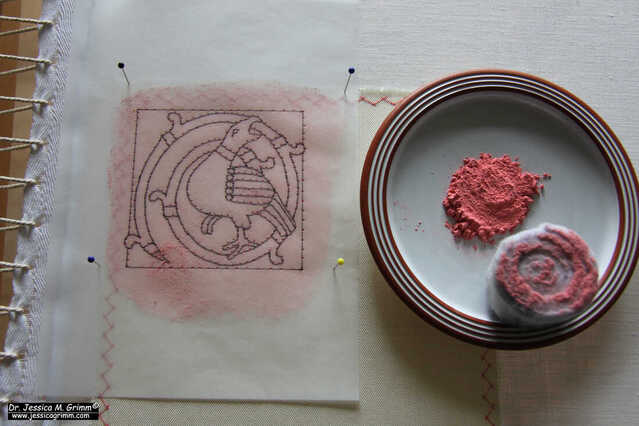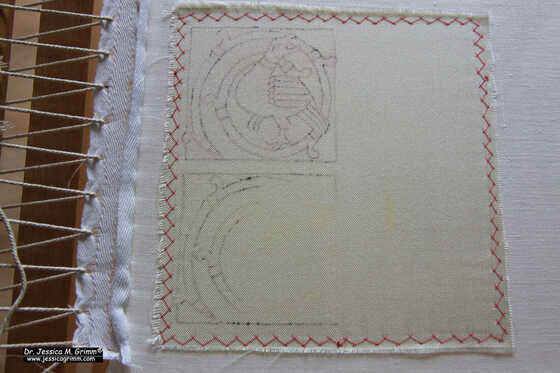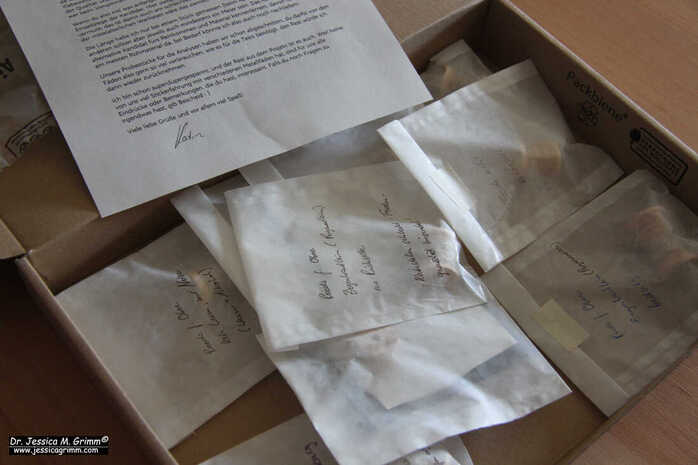|
Before I tell you all about some exciting experiments with pounce powder and membrane gold, let's talk about a new class in 2024. You might have heard that the Alpine Experience is now called Creative Experiences. They still offer amazing needlework retreats. In addition, they'll take you to different parts of Europe. Les Corroz in the French Alps is beautiful, but so are Tuscany and Scotland :). My next class will take part in Les Carroz. You will have a choice of three smaller medieval goldwork projects to choose from. They are designed so that you can really get a few medieval goldwork embroidery techniques under your belt. You can find pictures of the projects and a full description here. And now on to the experiments! Today, I set up a new slate frame with a piece of 46 ct linen. If you want to see how a slate frame is being set up, you can watch my free instruction videos in either English or German. I needed a 'fresh' frame as I wanted to do some more experimenting with some new pounce powder I had found a couple of weeks ago. As I am teaching a class in a couple of weeks, I really need to keep experimenting. I still have some pounce from Sarah Homfray, but that's running low. And, sometimes, her black charcoal pounce smudges quite a bit. That's why I now prefer her grey pounce. By the way, my workshop still has some free spaces. Just saying :). Originally, I had tested the new pounce powder on a piece of linen. The light-blue chalky powder worked really well and I liked it a lot. Today, I tried the red version and the yellow version on a piece of silk. With less success. Both smudged when I brushed them off. They left a red or a yellow hue on the naturally coloured silk. The question is: is this due to the pounce or due to the silk? Not sure yet. I will need to do a lot more testing! Now, I didn't need a whole slate frame for just the pounce experiments. Nope. I am going to do something much more exciting. See the above box? It represents Christmas, my Birthday and my Wedding Anniversary rolled into one. It contains samples of something that has not seen the light of day for a couple of centuries. It contains freshly made membrane gold. Correction: membrane silver. Gold was a little too expensive to mess around with :). Fellow archaeologist Dr Katrin Kania organised a study day to try to recreate these once ubiquitous metal threads. They are made by glueing thin sheets of metal onto animal gut (i.e. membrane). These are then cut into very thin strips and then wound around a silk or linen core. And we have a metal thread. Contrary, passing thread and Stech are made with a thicker strip of metal that does not need backing with a membrane. Due to its higher metal content, passing thread was more expensive than membrane threads were. But the membrane threads darkened quickly due to the very low gold content. But what does it feel like to stitch with them? Nobody has done that in the past couple of centuries. Soon I will! How cool is that?
4 Comments
NancyB
29/7/2023 11:37:35
Yes, indeed, very cool! Are you going to keep track of how quickly "quickly" is in regard to darkening of threads? So much to learn!
Reply
29/7/2023 11:54:09
Hmm, I probably would need advanced equipment for that to make it valid.
Reply
Michelle Santy
11/11/2023 01:21:02
So cool!
Reply
Your comment will be posted after it is approved.
Leave a Reply. |
Want to keep up with my embroidery adventures? Sign up for my weekly Newsletter to get notified of new blogs, courses and workshops!
Liked my blog? Please consider making a donation or becoming a Patron so that I can keep up the good work and my blog ad-free!
Categories
All
Archives
April 2024
|
Contact: info(at)jessicagrimm.com
Copyright Dr Jessica M. Grimm - Mandlweg 3, 82488 Ettal, Deutschland - +49(0)8822 2782219 (Monday, Tuesday, Friday & Saturday 9.00-17.00 CET)
Impressum - Legal Notice - Datenschutzerklärung - Privacy Policy - Webshop ABG - Widerrufsrecht - Disclaimer
Copyright Dr Jessica M. Grimm - Mandlweg 3, 82488 Ettal, Deutschland - +49(0)8822 2782219 (Monday, Tuesday, Friday & Saturday 9.00-17.00 CET)
Impressum - Legal Notice - Datenschutzerklärung - Privacy Policy - Webshop ABG - Widerrufsrecht - Disclaimer








 RSS Feed
RSS Feed